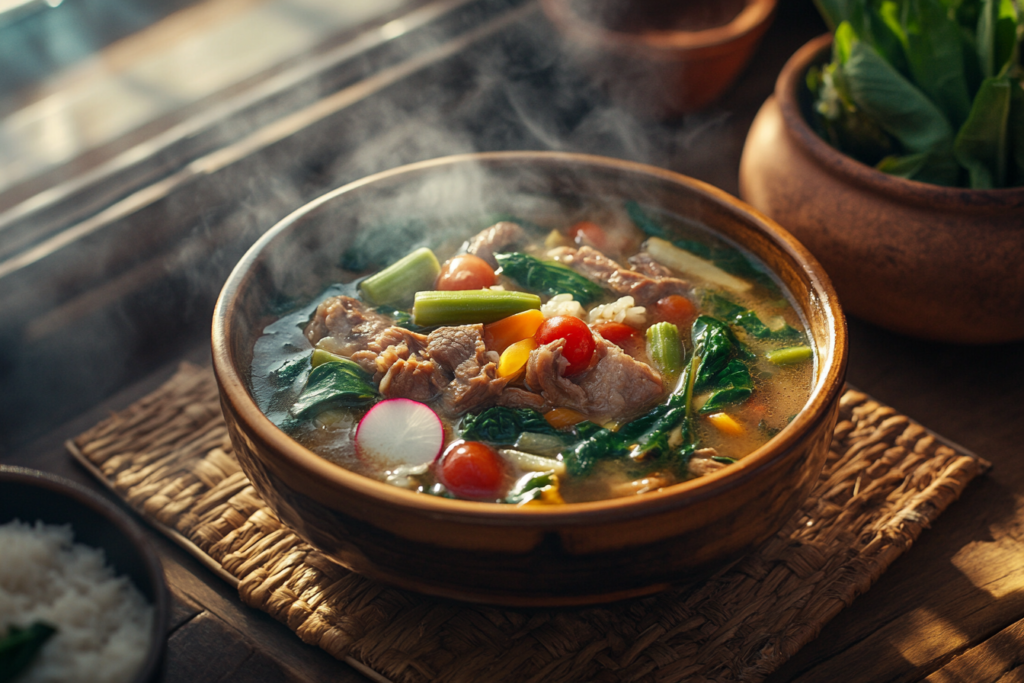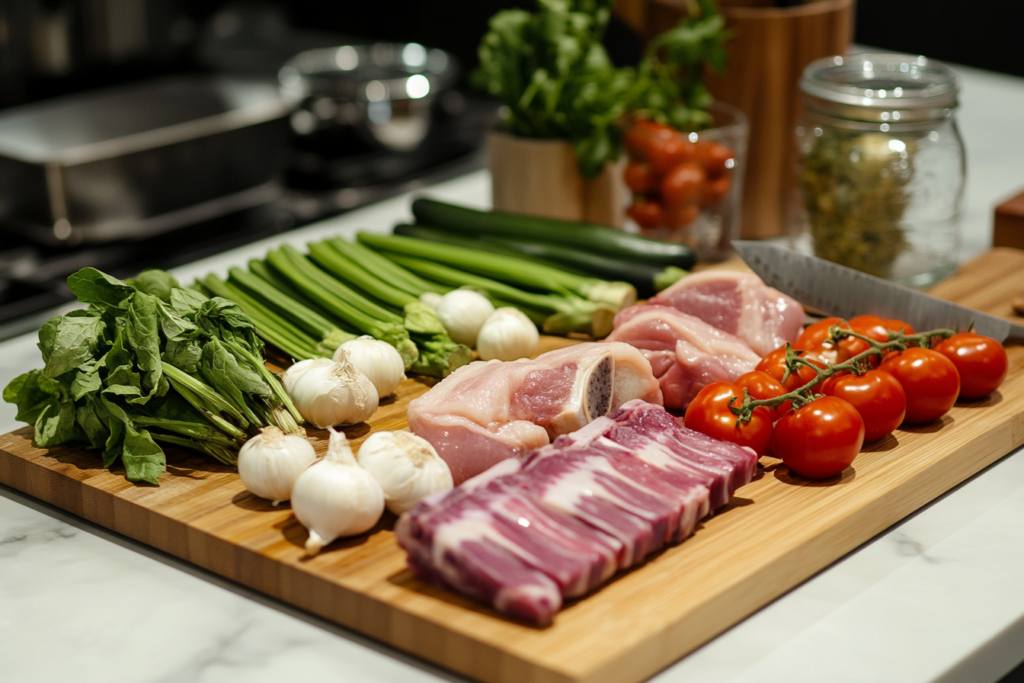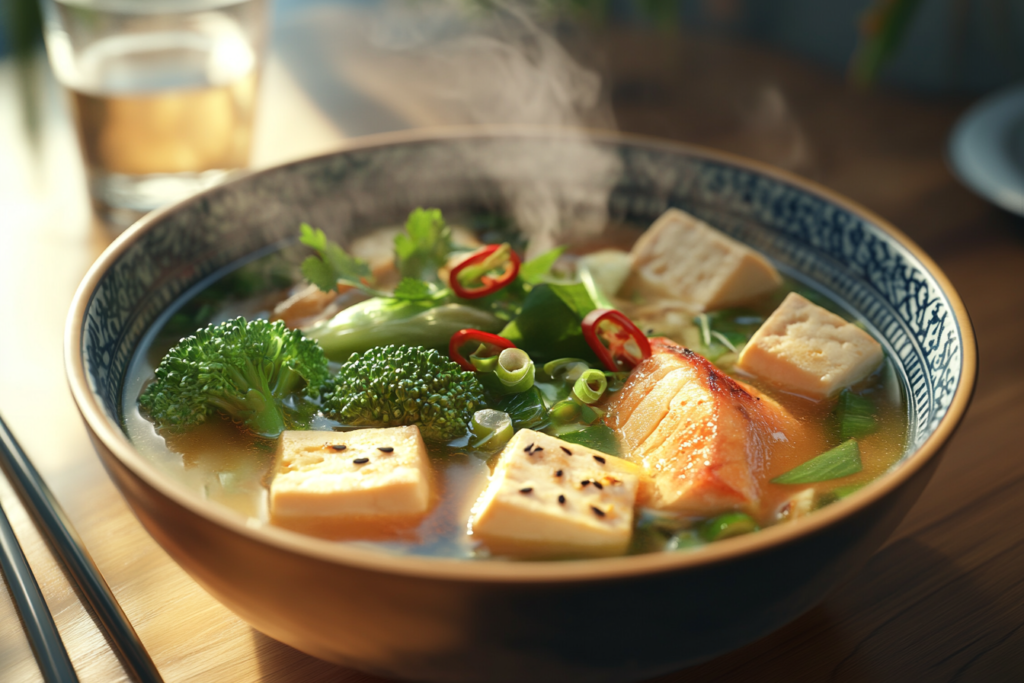1. Is Filipino Sinigang Healthy?
But is Filipino sinigang healthy? This article will explore the nutritional value, health benefits, and potential downsides of sinigang. We will also provide tips to make this dish even healthier without compromising its delightful taste.
By the end of this article, you’ll understand why sinigang holds a special place in Filipino cuisine and how it can be a nutritious addition to a balanced diet.
2. What is Filipino Sinigang?
2.1 The Origin and History of Filipino Sinigang
Sinigang traces its roots to the Philippines, where sour soups have been a staple for centuries. The dish reflects the country’s agricultural abundance, using fresh vegetables, meats, and natural souring agents to create a balanced flavor. Sinigang is often described as a “comfort food” because of its warm and soothing qualities.
The term “sinigang” comes from the Filipino word “sigang”, meaning to stew or boil. While its exact origin remains unknown, it has evolved over time, with each Filipino region putting its spin on the dish.
2.2 Popular Ingredients in Filipino Sinigang
Sinigang is versatile, and its ingredients can vary depending on local availability and personal preferences. However, the core components include:
- Proteins
- Shrimp (sinigang na hipon)
- Fish (milkfish or tilapia)
- Beef or chicken
- Vegetables
- Kangkong (water spinach)
- Radish
- Okra
- Tomatoes
- Eggplant
- Souring Agents
- Tamarind (most traditional)
- Calamansi (Filipino lime)
- Green mango
- Guava
The mix of vegetables and proteins gives sinigang its reputation as a nutrient-rich meal.
2.3 Variations of Filipino Sinigang

Filipino households have adapted sinigang to suit regional tastes and available ingredients. Here are a few popular variations:
- Sinigang na Hipon (Shrimp Sinigang)
- A seafood twist on the dish, with fresh shrimp as the main protein.
- Sinigang na Isda (Fish Sinigang)
- A lighter alternative using milkfish, tilapia, or salmon.
- Sinigang na Baka (Beef Sinigang)
- A heartier version that uses beef short ribs or shank.
- Vegetarian Sinigang
- A plant-based version focusing on tofu and an abundance of vegetables.
For a step-by-step guide to making sinigang, check out this traditional sinigang recipe.
3. Is Filipino Sinigang Healthy? Discover Its Nutritional Value
3.1 Caloric Breakdown
The calorie count of Filipino sinigang largely depends on the type of protein used. On average, a serving of sinigang contains between 200 to 350 calories, making it a relatively low-calorie dish.
- Sinigang na Baboy (Pork Sinigang): 300–350 calories per serving due to the fat content in pork belly.
- Sinigang na Hipon (Shrimp Sinigang): 200–250 calories per serving, as shrimp is lower in fat.
- Sinigang na Isda (Fish Sinigang): 220–280 calories, depending on the fish variety.
- Vegetarian Sinigang: 150–200 calories, mainly from vegetables and tofu.
Compared to other Filipino dishes like adobo or lechon, sinigang is a lower-calorie option, particularly when lean protein and plenty of vegetables are used.
3.2 Macronutrients in Sinigang
Sinigang provides a balance of macronutrients that are essential for a healthy diet.
- Protein: The dish is a good source of protein, especially when lean meats, fish, or shrimp are used. Proteins support muscle repair and overall body function.
- Carbohydrates: The vegetables in sinigang provide healthy carbs, while the dish is often paired with rice, which adds to the carb content.
- Fats: Depending on the protein used, the fat content can vary. Pork-based sinigang contains more saturated fat, while seafood and tofu versions are naturally lower in fat.
3.3 Micronutrients in Sinigang
One of the key benefits of Filipino sinigang is its rich micronutrient content. Each ingredient contributes essential vitamins and minerals:

3.3.1 Vegetables
- Kangkong (Water Spinach): High in Vitamin A and iron, promoting good eyesight and red blood cell production.
- Okra: Contains dietary fiber, Vitamin C, and folate, supporting digestion and immunity.
- Radish: Low-calorie but rich in antioxidants and Vitamin C.
- Tomatoes: Packed with lycopene, a powerful antioxidant that fights inflammation.
3.3.2 Souring Agents
- Tamarind: Rich in Vitamin C, antioxidants, and potassium, which help support the immune system and reduce inflammation.
- Calamansi: A potent source of Vitamin C and a natural immune booster.
3.3.3 Protein Sources
- Fish and Shrimp: Provide omega-3 fatty acids, which improve heart health.
- Tofu: A plant-based protein that offers calcium, iron, and low-fat protein for vegetarians.
3.4 Why Sinigang is Nutrient-Dense
Unlike fried or processed dishes, sinigang combines whole, natural ingredients. The vegetables retain most of their nutrients when cooked properly, while the broth absorbs essential vitamins and minerals from the ingredients.
Overall, sinigang offers a nutrient-dense meal that provides energy, essential vitamins, and minerals with relatively low calories.
4. The Health Benefits of Filipino Sinigang
Sinigang is not only a flavorful dish but also a nutritious one. Its combination of vegetables, proteins, and natural souring agents makes it a healthy addition to any diet. Below are some of the key health benefits of Filipino sinigang:
4.1 Rich in Vegetables
One of the standout features of sinigang is its abundance of fresh vegetables. Vegetables like kangkong, okra, radish, tomatoes, and eggplant provide essential vitamins, minerals, and dietary fiber.
- Boosts Immunity: Vegetables such as tomatoes and tamarind are rich in Vitamin C, which strengthens the immune system.
- Improves Digestion: Okra and radish are high in dietary fiber, promoting better digestion and preventing constipation.
- Lowers Inflammation: The antioxidants in tamarind and tomatoes help reduce inflammation in the body.
Including a variety of vegetables in sinigang ensures that it is nutrient-dense and packed with essential micronutrients.
4.2 Why Sinigang is a Low-Calorie Meal Option
Compared to fried or oily Filipino dishes, sinigang is a lower-calorie option. The combination of a light, clear broth and vegetables ensures that the dish is filling without being calorie-dense.
- Weight Management: A serving of sinigang provides around 200–350 calories, depending on the protein used. This makes it an ideal meal for those watching their calorie intake.
- Reduces Overeating: The high fiber content from vegetables and the broth’s satiety factor helps curb hunger and reduce overeating.
For more insights on balancing healthy meals, you might also ask: Is Carnation Breakfast healthy?
4.3 Hydration Benefits from Broth
The clear, tangy broth in sinigang offers excellent hydration benefits.
- Improved Digestion: Warm broth aids digestion and soothes the stomach.
- Boosts Electrolyte Balance: The broth, combined with vegetables, provides essential potassium and sodium, which help maintain electrolyte balance.
Drinking the broth ensures you retain the nutrients that may leach out of the vegetables during cooking.
4.4 Protein for Muscle Growth and Repair
Sinigang is a good source of protein, particularly when it includes meat, fish, shrimp, or tofu. Protein is essential for building and repairing muscles, supporting overall bodily functions.
- Fish and Shrimp: These proteins are low in fat and high in omega-3 fatty acids, which improve heart health and brain function.
- Tofu: A plant-based alternative that is cholesterol-free and rich in calcium and iron.
Including a variety of protein options in sinigang ensures it can cater to both meat-eaters and vegetarians.
4.5 Does Filipino Sinigang Support Weight Loss?
Sinigang is naturally light yet filling, making it an excellent choice for weight management.
- High Satiety: The combination of broth, fiber-rich vegetables, and protein helps you feel full for longer periods.
- Low in Fat: By choosing lean cuts of meat or seafood, sinigang minimizes saturated fat intake.
This makes Filipino sinigang healthy for individuals trying to maintain or lose weight without sacrificing flavor.
4.6 Anti-Inflammatory Properties
Tamarind, one of the most common souring agents in sinigang, is known for its anti-inflammatory properties.
- Reduces Inflammation: Tamarind contains antioxidants that combat oxidative stress in the body.
- Improves Heart Health: Tamarind’s potassium content helps regulate blood pressure and improve cardiovascular health.
By incorporating natural souring agents like tamarind, sinigang becomes a functional food that supports overall health.
5. Is Filipino Sinigang Healthy? Potential Downsides
While Filipino sinigang offers many health benefits, there are a few potential downsides that should be considered. These primarily relate to how the dish is prepared and the ingredients used. By understanding these concerns, you can make adjustments to enjoy sinigang in a healthier way.
5.1 Managing Sodium Content in Sinigang
One of the key ingredients in sinigang is fish sauce (patis), which adds a salty umami flavor. While fish sauce enhances the taste, it can significantly increase the sodium content of the dish.
- Impact on Health: Excess sodium intake can lead to high blood pressure, increasing the risk of heart disease and stroke.
- Hidden Sodium: If pre-made sinigang mix or bouillon cubes are used as souring agents, they often contain added sodium, preservatives, and MSG.
How to Reduce Sodium in Sinigang:
- Use a smaller amount of fish sauce or replace it with low-sodium soy sauce.
- Opt for natural souring agents like fresh tamarind or calamansi instead of processed sinigang mixes.
- Add herbs and spices, such as garlic or ginger, for flavor without increasing salt.
5.2 Nutrient Loss from Overcooking Vegetables
Vegetables are a key part of Filipino sinigang and contribute to its health benefits. However, cooking vegetables for too long can lead to significant nutrient loss.
- Vitamin Degradation: Water-soluble vitamins like Vitamin C and B vitamins are sensitive to heat and can break down if vegetables are overboiled.
- Loss of Texture: Overcooking can also make vegetables mushy, reducing their appeal and fiber content.
Tips to Retain Nutrients in Vegetables:
- Add vegetables toward the end of cooking to preserve their texture and nutrient content.
- Use fresh, high-quality produce for the best results.
- Avoid boiling the vegetables excessively; they should be tender yet slightly crisp.
5.3 Dietary Considerations for Specific Health Conditions
While sinigang is generally nutritious, individuals with certain health conditions should approach the dish with caution:
- Gout: High-purine ingredients like pork and shrimp can worsen symptoms. Opt for fish or tofu instead.
- Hypertension: Sodium-rich ingredients like fish sauce and sinigang mixes should be minimized. Use low-sodium alternatives.
- Heart Disease: Limit fatty meats and focus on lean proteins or plant-based versions.
By being mindful of ingredients and cooking methods, individuals with dietary restrictions can still enjoy a healthier version of Filipino sinigang.
6. How to Make Filipino Sinigang Healthier
Sinigang is already a nutritious dish, but with a few tweaks, you can make it even healthier. By focusing on ingredients and cooking methods, you can maximize the health benefits while keeping its signature tangy flavor.
6.1 Choosing Lean Proteins for Sinigang
Protein is a key component of Filipino sinigang, but the type of protein you use greatly impacts its healthiness.
- Switch to Fish or Shrimp: Fish like milkfish, tilapia, or salmon is rich in omega-3 fatty acids, which support heart health. Shrimp is another low-fat alternative that adds plenty of flavor.
- Use Chicken Breast: A lean protein option that provides essential nutrients with minimal fat.
- Try Tofu for a Plant-Based Twist: Tofu is a great source of protein, calcium, and iron for vegetarians.
By choosing leaner proteins, you can reduce saturated fat while maintaining the dish’s nutritional value.
6.2 Using Natural Souring Agents for a Healthier Sinigang
High sodium levels in sinigang often come from fish sauce, processed sinigang mixes, or bouillon cubes. To make the dish healthier:
- Limit Fish Sauce: Use a smaller amount of fish sauce or replace it with low-sodium soy sauce.
- Use Natural Souring Agents: Replace pre-made mixes with fresh tamarind, calamansi, or green mango to avoid added salt and preservatives.
- Enhance Flavor with Herbs and Spices: Garlic, onion, and ginger can elevate the taste without increasing sodium content.
This approach retains the savory flavor of sinigang while making it suitable for individuals with high blood pressure or heart concerns.
6.3 Maximizing Vegetables to Boost Nutritional Value
Adding more vegetables to sinigang not only increases its nutritional value but also enhances its taste and texture.
- Include nutrient-rich vegetables like:
- Broccoli and spinach for extra Vitamin K and antioxidants.
- Eggplant and okra for fiber and Vitamin C.
- Carrots and sweet potatoes for additional nutrients like beta-carotene.
- Don’t Overcook Vegetables: Add vegetables near the end of cooking to retain their nutrients, vibrant color, and slight crunch.
For creative ways to include napa cabbage or other vegetables in dishes, check out these napa cabbage recipes.
6.4 Using Natural Souring Agents
Natural souring agents are what make Filipino sinigang unique. Instead of processed sinigang mixes, opt for fresh alternatives:

- Tamarind: A traditional souring agent rich in antioxidants and Vitamin C.
- Calamansi: Adds a refreshing citrus flavor and boosts immunity.
- Green Mango: Offers a tangy taste and is packed with Vitamin C and fiber.
- Guava: A unique souring agent with a mildly sweet and sour flavor.
Using fresh souring agents ensures that sinigang remains natural and free from artificial preservatives.
6.5 Controlling Portion Sizes
To enjoy sinigang in moderation:
- Pair a smaller serving of sinigang with whole-grain rice or quinoa for additional fiber.
- Focus on loading your bowl with more vegetables and lean protein.
- Limit portion sizes of white rice to manage carb intake effectively.
By controlling portion sizes and balancing the meal, sinigang can be part of a healthy, well-rounded diet.
7. Comparing Filipino Sinigangto Other Filipino Dishes
Sinigang stands out among other Filipino dishes because of its balanced ingredients and cooking method.
7.1 Sinigang vs. Adobo
- Adobo is often cooked with soy sauce and vinegar, which increases sodium content. It also includes frying or sautéing, adding extra fat.
- Sinigang has a lighter, clear broth with lower fat content, especially when lean protein is used.
7.2 Sinigang vs. Nilaga
- Nilaga is similar to sinigang but lacks the souring agents that provide extra vitamins and antioxidants.
- Both dishes feature vegetables, but sinigang offers a more complex flavor profile and additional health benefits from tamarind or calamansi.
7.3 Sinigang vs. Fried Dishes
- Fried dishes like lechon kawali or fried tilapia are high in saturated fat and calories.
- Sinigang uses boiling, a healthier cooking method that reduces oil and fat content.
Compared to many Filipino favorites, Filipino sinigang is healthy because of its natural ingredients, lower fat, and balanced flavors.
8. FAQs: Is Filipino Sinigang Healthy?
1. Is Sinigang Good for Weight Loss?
Yes, sinigang is a low-calorie dish when prepared with lean protein and plenty of vegetables. Its broth and fiber help keep you full, making it ideal for weight management.
2. Can People with High Blood Pressure Eat Sinigang?
Yes, but it’s important to reduce the use of fish sauce and processed sinigang mixes to control sodium intake. Opt for fresh souring agents and herbs to maintain flavor.
3. What is the Healthiest Protein Option for Sinigang?
Fish, shrimp, chicken breast, and tofu are the healthiest protein options, as they are lower in saturated fat compared to pork.
4. How Can I Reduce Sodium in Sinigang Without Losing Flavor?
Use fresh tamarind, calamansi, or green mango as souring agents. Reduce fish sauce and enhance flavor with herbs like garlic, onion, and ginger.
5. Can Vegetarians Enjoy Sinigang?
Absolutely! Vegetarian sinigang can be made with tofu and an assortment of vegetables, using tamarind or calamansi for the sour broth.
9. Conclusion
Sinigang is a beloved Filipino dish that offers a unique blend of flavors and health benefits. Packed with fresh vegetables, lean protein, and natural souring agents, it is a nutritious and satisfying meal.
While there are potential downsides, such as high sodium or fat content, these can be easily managed with mindful ingredient choices and cooking methods. By using lean proteins, natural souring agents, and maximizing vegetables, you can enjoy a healthier version of sinigang that fits into a balanced diet.
Whether you’re trying to lose weight, manage your sodium intake, or simply enjoy a comforting and flavorful meal, Filipino sinigang proves that traditional dishes can also be healthy.
